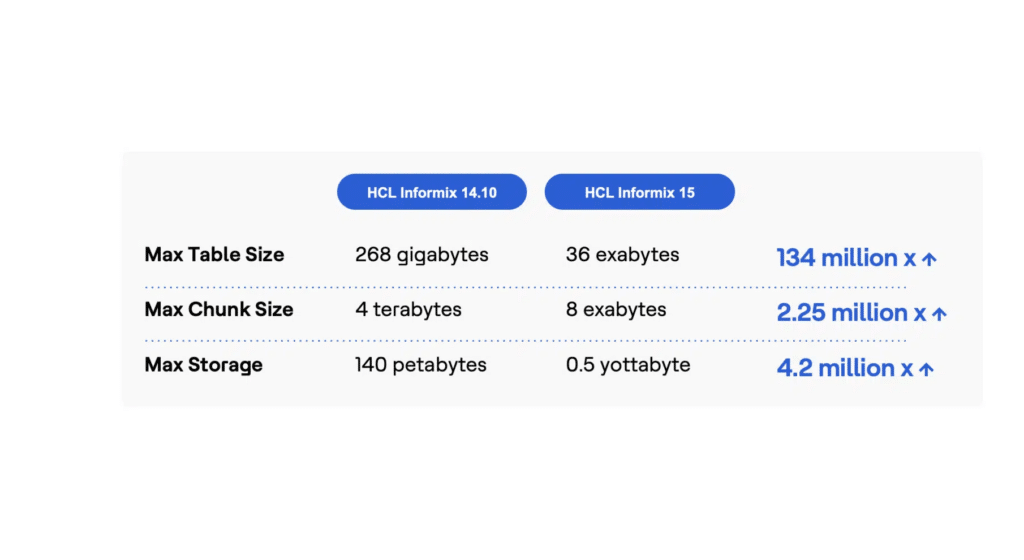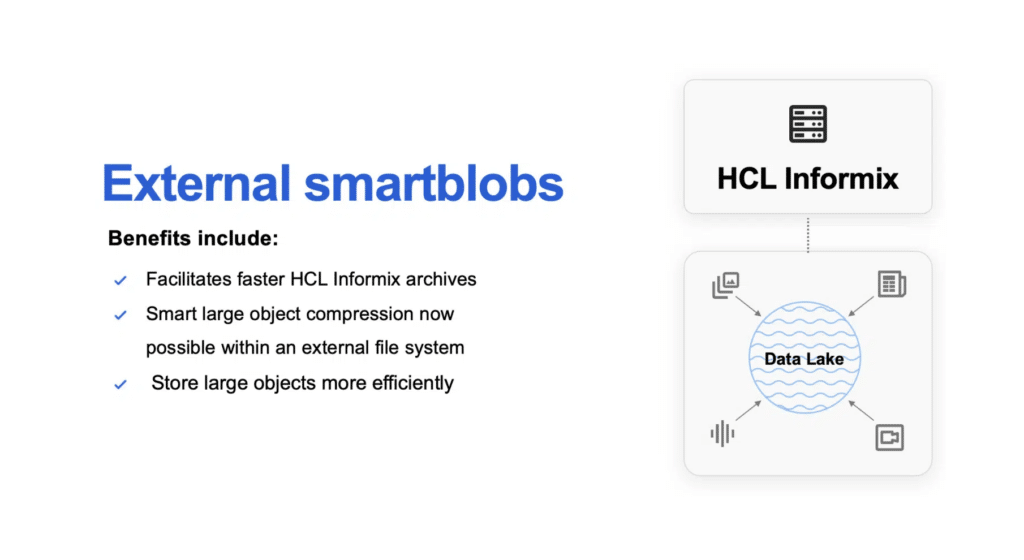Experience Near-Unlimited Storage Capacity With HCL Informix® 15
Emily Taylor
November 12, 2024

We are thrilled to unveil HCL Informix® 15, re-imagined for organizations looking for the best way to modernize out-of-support IBM® Informix® applications. Our customers love HCL Informix because it is fast, reliable, and scalable. With the release of HCL Informix 15, we build upon this proud heritage with:
- HCL Informix 4GL, a fourth-generation business application development environment that is designed to simplify the building of data-centric business applications, now available from Actian.
- Larger row and page addresses that enhance scalability for large-scale data storage and processing. The new maximum capacity for a single instance is four times the estimated size of the internet.
- External smartblobs enables the storage of binary large objects like static documents, videos and photos in an external file system to facilitate faster archiving.
- Invisible indexes help developers and DBAs fine-tune queries by identifying which indexes are critical to specific queries by flexibly omitting them to see if they impact query runtime.
These capabilities fortify HCL Informix’s already solid foundation to underpin the next generation of mission-critical applications. They reflect our vision for a more powerful offering that guarantees seamless business continuity and secures the longevity of your organization’s existing applications.
HCL Informix 15 now includes cloud-enabled product capabilities including a Kubernetes containerization deployment option and updated REST APIs (previously only available in HCL OneDB). For customers using HCL OneDB 1.0 and 2.0, we will adhere to the announced lifecycle dates and work with you on a recommended in-place upgrade to HCL Informix.
HCL Informix customers like Equifax are looking forward to taking advantage of these new capabilities to improve their business use cases in the near future.
“HCL Informix 15 will empower Equifax to quickly process a steady stream of payments, claims decisions, tax verifications, and more, enabling us to make data-driven decisions,” said Nick Fuller, Associate Vice President of Technology at Equifax. “Its capacity to handle vast amounts of data gives us confidence in its ability to meet our demand for rapid and efficient processing.”
HCL Informix: Building an Advanced Database for Modern Enterprise Applications
4GL: Easily maintain and recompile existing 4GL applications

While many IBM Informix customers are familiar with 4GL, Actian is now offering HCL Informix 4GL and HCL Informix SQL for the first time. HCL Informix customers can leverage 4GL and ISQL to develop and debug applications, including building new menus, forms, screens, and reports with ease. 4GL reduces the time it takes to build and maintain HCL Informix applications and perform database operations like querying, updating, and managing data. Informix 4GL has a powerful report writer that enables the creation of complex reports. This capability is particularly useful for generating business reports from data stored in HCL Informix.
HCL Informix 4GL accelerates the building of applications such as:
- Accounting Systems: Track money owed by and to the business, including invoicing, payment processing, and reports.
- Inventory Management Systems: Manage storage locations, stock movements, and inventory audits.
- Human Resources Systems: Maintain detailed records of employee information, performance, and benefits.
HCL Informix 15 Server Re-Architected for Massive Storage Capacity Improvement
Larger Row and Page Addresses: Manage Large Data Sets Without Compression
Have peace of mind knowing that data volume limitations are an issue of the past with HCL Informix 15. That means improved reliability and better use of resources because organizations won’t need to compress or fragment tables.
When Informix Turbo launched in 1989, Informix architects believed 4 bytes would more than suffice for uniquely addressing each row so each page could hold a max of 255 rows and each table could have a maximum of 16.7 million pages. Now, some of the largest HCL Informix customers are pushing those original limits to their edge. While it is possible to fragment tables to get around the max page limit, that’s an imperfect solution at scale. So we’ve expanded storage limits dramatically so max storage capacity is half a yottabyte, four times the estimated size of the internet.

External Smartblobs: Store Large Objects With Ease

Large objects like video or audio have traditionally been difficult for transactional databases like HCL Informix to manage because they need to be compressed to store the object efficiently, which takes time.
With HCL Informix 15, external Smartblobs enable developers to store the objects in a file system, while only keeping a record of the metadata. Instead of compressing the data, users can now create a special smartblob space to store the file metadata, with the object files stored externally.
External Smartblobs delivers benefits across a variety of use cases including:
- Quality Assurance: Analyze how well a real-time monitoring system built on HCL Informix detects faulty products on an assembly line. Auditors can identify the product that was discarded in the metadata to find the image files of the faulty product without impacting the underlying application.
- Tax Authority: Tax administrators need to capture tax returns in case they need to audit a company or individual. They can store the static tax return documents with a specific ID and access them through the HCL Informix application just by using the metadata.
Invisible Indexes: Optimize Your Queries Faster
Indexes are special data structures that improve the speed of data retrieval operations on a database table. They work similarly to an index in a book, allowing the database to find and access the data faster without having to scan every row in a table. However, not every index will be used for the queries in an application. HCL Informix 15 enables users to make certain indexes invisible when running an application to help test which indexes impact queries and which ones do not for better operational efficiency.
Invisible indexes support real-world use cases such as:
- E-commerce Platforms often deal with large volumes of transactions and queries. Invisible indexes can be used to test and optimize query performance without disrupting the shopping experience.
- Healthcare System databases require efficient data retrieval for patient records and research. Invisible indexes can help optimize these queries without affecting the overall system.
- Customer Relationship Management (CRM) systems handle vast amounts of customer data. Invisible indexes can be used to improve the performance of specific queries related to customer interactions and their history.
Start Your Modernization Project With HCL Informix 15
The Actian team is ready to support you as you get started on your modernization project with HCL Informix 15.
Check out the on-demand webinar “Secure Your Future with HCL Informix® 15” to learn more about HCL Informix 15. Also, see how your peers are using HCL Informix to modernize their applications. Plus, wait until the end to hear about our limited one-time offer.
Additional Resources:
- Four Ways an Off-Support Database Can Derail Your Business
- Modernize Your Business Critical Applications with HCL Informix
- Application Use Cases Powered by HCL Informix
- Application Modernization Checklist
Informix is a trademark of IBM Corporation in at least one jurisdiction and is used under license.
Subscribe to the Actian Blog
Subscribe to Actian’s blog to get data insights delivered right to you.
- Stay in the know – Get the latest in data analytics pushed directly to your inbox.
- Never miss a post – You’ll receive automatic email updates to let you know when new posts are live.
- It’s all up to you – Change your delivery preferences to suit your needs.
